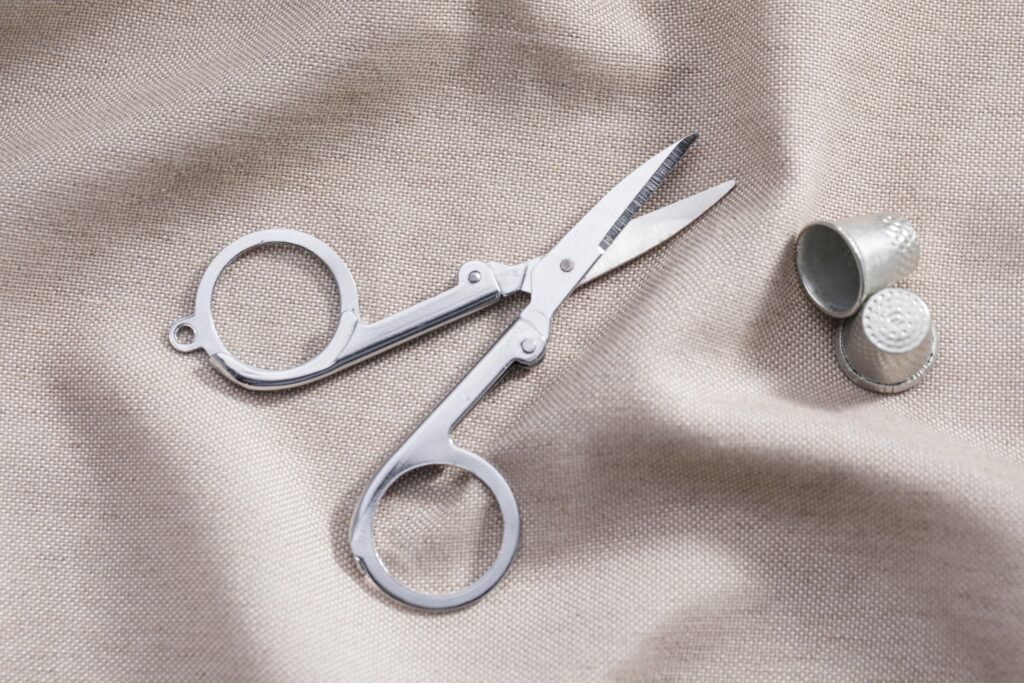
Keeping our sewing scissors in optimal condition is essential to achieving precise cuts and professional finishes on any project. With continued use, it is normal for scissors to become dull and not cut as well as before.
Fortunately, learning how to sharpen sewing scissors at home is a simple process that will allow you to extend their life without having to invest in new cutting tools. In this article, we will show you several practical methods to sharpen your scissors effectively and always keep them ready for your creations.
Why do you need to sharpen your sewing scissors regularly?
Scissors are an essential tool for any sewing enthusiast, whether you are cutting fabric, threads or making precise details. As you use them, the edge of the scissors wears down, which can lead to uneven cuts, damage to fabrics, and even cause frustration during work.
Sharpening your scissors regularly not only improves their performance, but also ensures that cuts are smooth and precise. Keeping your scissors sharp will allow you to work more efficiently and carefully, preventing them from snagging or tearing the fabric.
Benefits of sharpening scissors:
- Cleaner and more precise cuts.
- Prolonging the useful life of your scissors.
- Greater comfort when working.
- Prevention of damage to fabrics.
Now that you know the importance of keeping your scissors in good condition, we show you some simple methods to sharpen scissors at home.
Method 1: How to Sharpen Scissors with Aluminum Foil
One of the most popular and simplest methods to sharpen scissors is using aluminum foil, a material that is easy to obtain and very effective in restoring the edge to your cutting tools.
Steps to sharpen scissors with aluminum foil:
- Get a sheet of aluminum foil.
Puedes utilizar un trozo de unos 20 cm de largo. - Fold the aluminum foil several times to create an appropriate thickness (4 to 5 folds).
- Cut the aluminum foil with your scissors, making complete cuts from top to bottom. Make at least 10 cuts, making sure the scissors go completely through the paper.
- Try the edge of the scissors with a piece of cloth. If you notice that they still don’t cut well, repeat the process a couple more times.
This method is ideal for maintaining sharpness quickly and effectively between frequent uses. Here is a video to see this method in action:
Method 2: Sharpen scissors with sandpaper or whetstone
Using sandpaper or a sharpening stone is a more traditional technique, but very effective to restore the edge to your sewing scissors. It is ideal for scissors that have already lost a lot of edge or have difficulty cutting.
Steps to sharpen scissors with sandpaper or whetstone:
- Select a fine grit sandpaper or a specific sharpening stone for blades. The sandpaper should have a grit between 200 and 400 for best results.
- Open the scissors and place the blade on the sandpaper at an angle of about 10 degrees.
- Slide the blade of the scissors over the sandpaper in the opposite direction to the edge, as if you were sharpening a knife. Make gentle and repeated movements.
- Repeat the process several times, both on the inside and outside of each leaf.
- Test the filo with a piece of cloth or paper to make sure the scissors cut correctly.
This method may require more practice, but once mastered, it is one of the most durable and effective. You can also see some methods here:
Method 3: Sharpen scissors with a screwdriver
If you don’t have aluminum foil or a sharpening stone on hand, a screwdriver can be a great improvised tool for sharpening your scissors.
Steps to sharpen scissors with a screwdriver:
- Get a screwdriver and a similar metal bar.
- Open the scissors and place the screwdriver between the blades of the scissors, as if you were going to cut it.
- Make cutting movements on the screwdriver, sliding it along the blades of the scissors. Make sure the screwdriver is in contact with the sharp edges of the blades.
- Repeat the process several times until you notice that the sharpness has improved.
This method is quick and practical, ideal for emergency sharpening when you need your scissors at a moment’s notice.
When is it time to invest in a scissor sharpener?
While at-home methods are effective in keeping your scissors sharp on a day-to-day basis, there may be times when your scissors need a more professional solution. If you notice that, despite regular sharpening, your scissors are still not working properly or the edge is not lasting as long as it used to, it may be time to consider a sewing scissor sharpener.
No se han encontrado productos.
Sewing scissors sharpener: Your best ally
Investing in a scissor sharpener may be the best option if you use your scissors constantly and need them to always be in optimal condition. These sharpeners are designed specifically for cutting tools, ensuring more precise and long-lasting sharpening than homemade methods.
Advantages of using a scissor sharpener:
- Easy to use: Manual or electric sharpeners are easy to use, even for those without experience.
- Professional results: Provide a more consistent and long-lasting edge.
- Versatility: Many sharpeners are suitable for different types of scissors and blades.
If you dedicate yourself to sewing professionally or simply want to ensure the durability of your tools, investing in a sewing scissors sharpener is an excellent option. In our online store, you will find the best sharpeners to take care of your scissors and keep your sewing projects always ready.
Keeping your sewing scissors sharp is essential to ensure precise cuts and high-quality work. With these homemade methods, you can extend the life of your tools and enjoy a more efficient sewing experience. Whether it’s aluminum foil, sandpaper, a screwdriver, or a professional sharpener, you now know how to keep your scissors in optimal condition from the comfort of your home.